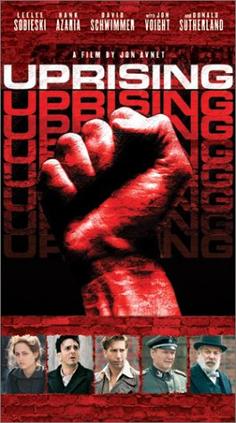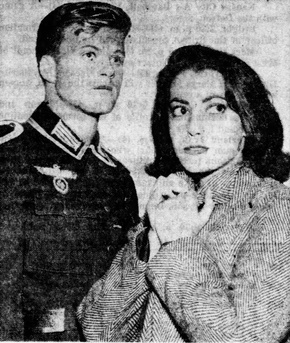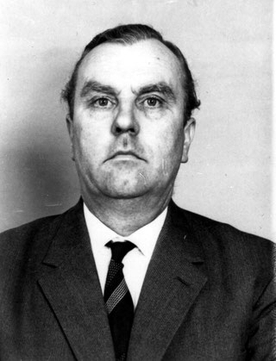
The Warsaw Ghetto was the largest of the Nazi ghettos during World War II and the Holocaust. It was established in November 1940 by the German authorities within the new General Government territory of occupied Poland. At its height, as many as 460,000 Jews were imprisoned there, in an area of 3.4 km2 (1.3 sq mi), with an average of 9.2 persons per room, barely subsisting on meager food rations. Jews were deported from the Warsaw Ghetto to Nazi concentration camps and mass-killing centers. In the summer of 1942, at least 254,000 ghetto residents were sent to the Treblinka extermination camp during Großaktion Warschau under the guise of "resettlement in the East" over the course of the summer. The ghetto was demolished by the Germans in May 1943 after the Warsaw Ghetto Uprising had temporarily halted the deportations. The total death toll among the prisoners of the ghetto is estimated to be at least 300,000 killed by bullet or gas, combined with 92,000 victims of starvation and related diseases, the Warsaw Ghetto Uprising, and the casualties of the final destruction of the ghetto.

Mordechai Anielewicz was the leader of the Jewish Combat Organization during the Warsaw Ghetto Uprising; the largest Jewish resistance movement during the Second World War. Anielewicz inspired further rebellions in both ghettos and extermination camps with his leadership. His character was engraved as a symbol of courage and sacrifice, and was a major figure of Jewish resistance during the Holocaust.
A resistance movement is an organized group of people that tries to resist the government or an occupying power, causing disruption and unrest in civil order and stability. Such a movement may seek to achieve its goals through either the use of violent or nonviolent resistance, or the use of force, whether armed or unarmed. In many cases, as for example in the United States during the American Revolution, or in Norway in the Second World War, a resistance movement may employ both violent and non-violent methods, usually operating under different organizations and acting in different phases or geographical areas within a country.

The ghetto uprisings during World War II were a series of armed revolts against the regime of Nazi Germany between 1941 and 1943 in the newly established Jewish ghettos across Nazi-occupied Europe. Following the German and Soviet invasion of Poland in September 1939, Polish Jews were targeted from the outset. Within months inside occupied Poland, the Germans created hundreds of ghettos in which they forced the Jews to live. The new ghettos were part of the German official policy of removing Jews from public life with the aim of economic exploitation. The combination of excess numbers of inmates, unsanitary conditions and lack of food resulted in a high death rate among them. In most cities the Jewish underground resistance movements developed almost instantly, although ghettoization had severely limited their access to resources.

The Jewish Combat Organization was a World War II resistance movement in occupied Poland, which was instrumental in organizing and launching the Warsaw Ghetto Uprising. ŻOB took part in a number of other resistance activities as well.

The Warsaw Ghetto Uprising was the 1943 act of Jewish resistance in the Warsaw Ghetto in German-occupied Poland during World War II to oppose Nazi Germany's final effort to transport the remaining ghetto population to the gas chambers of the Majdanek and Treblinka extermination camps.

Jürgen Stroop was a German SS commander during the Nazi era, who served as SS and Police Leader in occupied Poland and Greece. He led the suppression of the Warsaw Ghetto Uprising in 1943 and wrote the Stroop Report, a book-length account of the operation. Following the defeat of Germany, Stroop was prosecuted during the Dachau Trials and convicted of murdering nine U.S. prisoners of war. After his extradition to Poland, Stroop was tried, convicted, and executed for crimes against humanity.

Uprising is an American 2001 war drama television film about the Warsaw Ghetto Uprising during the Holocaust. The film was directed by Jon Avnet and written by Avnet and Paul Brickman. It was first aired on the NBC television network over two consecutive nights in November 2001.

Ferdinand von Sammern-Frankenegg was an Austrian SS functionary (Brigadeführer) during the Nazi era. He was born in Grieskirchen. Von Sammern-Frankenegg served in World War I as a member of the Kaiserschützen, then of the K.u.k. Feldjäger and then after Austria-Hungary had formally surrendered, in the German Freikorps Oberland and the Steirischer Heimatschutz. Ferdinand von Sammern-Frankenegg earned his PhD in legal studies at the University of Innsbruck in 1922. He had been a member of the dueling fraternity Universitätssängerschaft Skalden zu Innsbruck. Von Sammern-Frankenegg worked as a lawyer in Peuerbach.

The Anielewicz Bunker, also known as the Anielewicz Mount was the headquarters and hidden shelter of the Jewish Combat Organization (ŻOB), a Jewish resistance group in the Warsaw Ghetto in Poland during the Nazi German occupation of World War II.

Jewish resistance under Nazi rule took various forms of organized underground activities conducted against German occupation regimes in Europe by Jews during World War II. According to historian Yehuda Bauer, Jewish resistance was defined as actions that were taken against all laws and actions acted by Germans. The term is particularly connected with the Holocaust and includes a multitude of different social responses by those oppressed, as well as both passive and armed resistance conducted by Jews themselves.

In Poland, the resistance movement during World War II was led by the Home Army. The Polish resistance is notable among others for disrupting German supply lines to the Eastern Front, and providing intelligence reports to the British intelligence agencies. It was a part of the Polish Underground State.

Josef Blösche was a convicted war criminal and a member of the Nazi Party who served in the SS and SD during World War II. Blösche shot and killed many Jews, and helped send many more Jews to their deaths in extermination camps. He also participated in several massacres.

The Grossaktion Warsaw was the Nazi code name for the deportation and mass murder of Jews from the Warsaw Ghetto during the summer of 1942, beginning on 22 July. During the Grossaktion, Jews were terrorized in daily round-ups, marched through the ghetto, and assembled at the Umschlagplatz station square for what was called in the Nazi euphemistic jargon "resettlement to the East". From there, they were sent aboard overcrowded Holocaust trains to the extermination camp in Treblinka.

Counting Up, Counting Down is a collection of short stories by Harry Turtledove, most of which were first published in various fiction magazines in the 1990s. It is named after two of the stories appearing in the book, one called "Forty, Counting Down" and the other named "Twenty-One, Counting Up", which are united by the character of Justin Kloster. The story genres represented include alternate history, time travel, fantasy, straight historical fiction, and more. Two stories, "The Decoy Duck" and "The Seventh Chapter," are set in the Videssos Universe, with the former story being set before any of the other stories and books in that universe. The book was originally published by Del Rey as a trade paperback in January 2002. In the same month, it was brought out as a leatherbound limited edition by Easton Press.

Erich Steidtmann was a Nazi SS officer believed to have been involved in the liquidation of the Warsaw Ghetto Uprising, the largest single revolt by the Jews during the Holocaust, the bulk of which occurred from April 19 until May 16, 1943, ending when the resistance was crushed by German troops under the direct command of Jürgen Stroop. Efforts were being undertaken by German prosecutors in the months before his death to prosecute Steidtmann for his involvement in war crimes.

In the best-known photograph taken during the 1943 Warsaw Ghetto Uprising, a boy holds his hands over his head while SS-Rottenführer Josef Blösche points a submachine gun in his direction. The boy and others hid in a bunker during the final liquidation of the ghetto, but they were caught and forced out by German troops. After the photograph was taken, all of the Jews in the photograph were marched to the Umschlagplatz and deported to Majdanek extermination camp or Treblinka. The exact location and the photographer are not known, and Blösche is the only person in the photograph who can be identified with certainty. The image is one of the most famous photographs of the Holocaust, and the boy came to represent children in the Holocaust, as well as all Jewish victims.

A well-known Holocaust photograph depicts three Jewish women who fought in the Warsaw Ghetto Uprising, took shelter in a bunker with a weapons cache, and were forced out by SS soldiers. One of the women, Bluma Wyszogrodzka (center), was shot. The other two, Małka Zdrojewicz (right) and Rachela Wyszogrodzka (left) were marched to the Umschlagplatz and deported to Majdanek concentration camp, where Wyszogrodzka was murdered.

"In the Presence of Mine Enemies" was an American television play broadcast on May 18, 1960. It was the 16th episode of the fourth season of the CBS television series Playhouse 90, and also the final broadcast in the show's four-year run.

Karl Heinrich Klaustermeyer was a member of the Nazi Party who served in the Gestapo, NSKK, and SA. During World War II, he was stationed in the Warsaw Ghetto, where he personally murdered multiple Jewish civilians and participated in the suppression of the Warsaw Ghetto Uprising. After the war, he settled down in West Germany. Klaustermeyer was investigated by German prosecutors and arrested in the early 1960s. In 1965, he was found guilty of war crimes and sentenced to life in prison by the Bielefeld regional court. He was released from prison in 1976 on health grounds due to terminal cancer and died less than two weeks later.
















